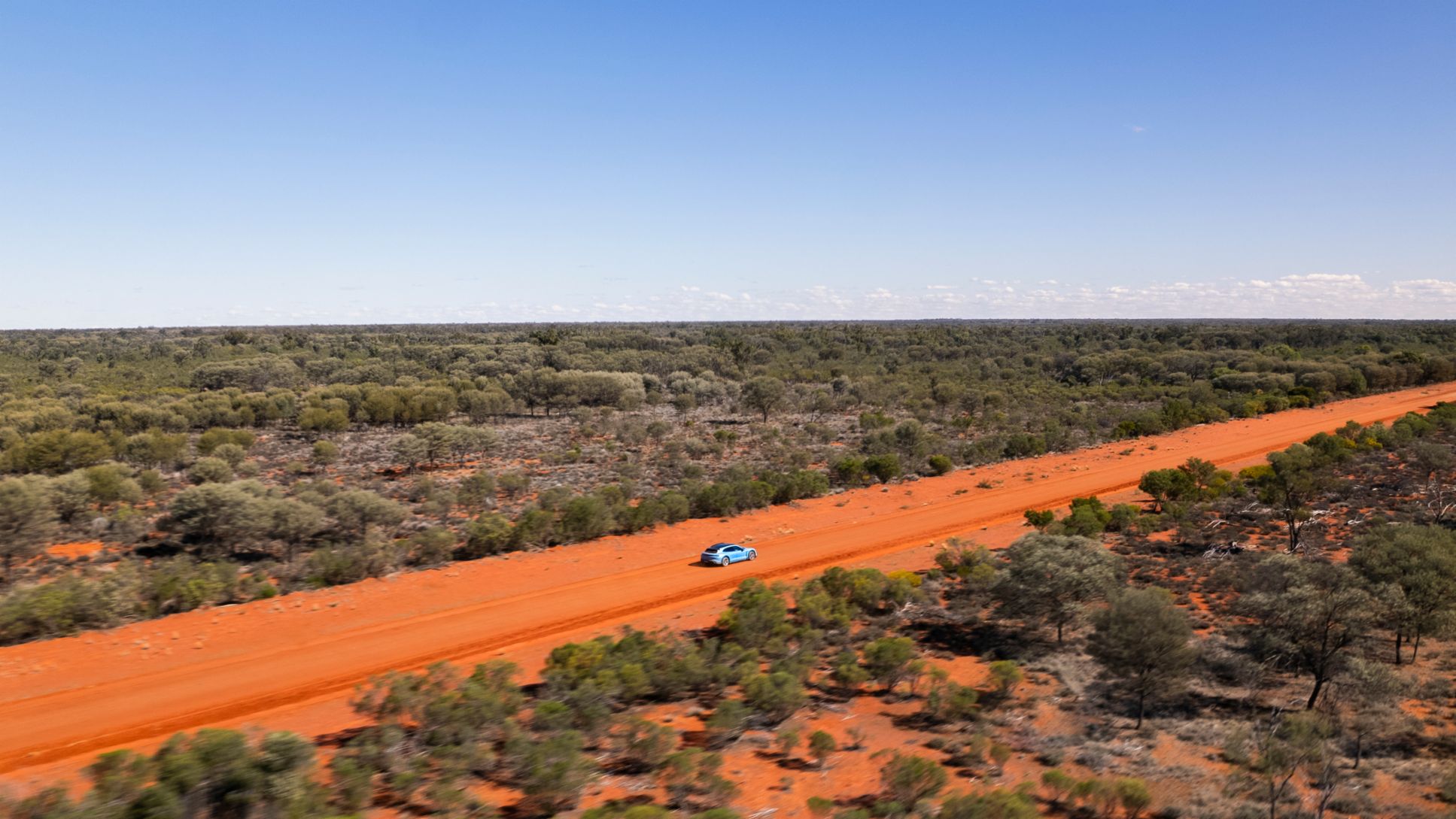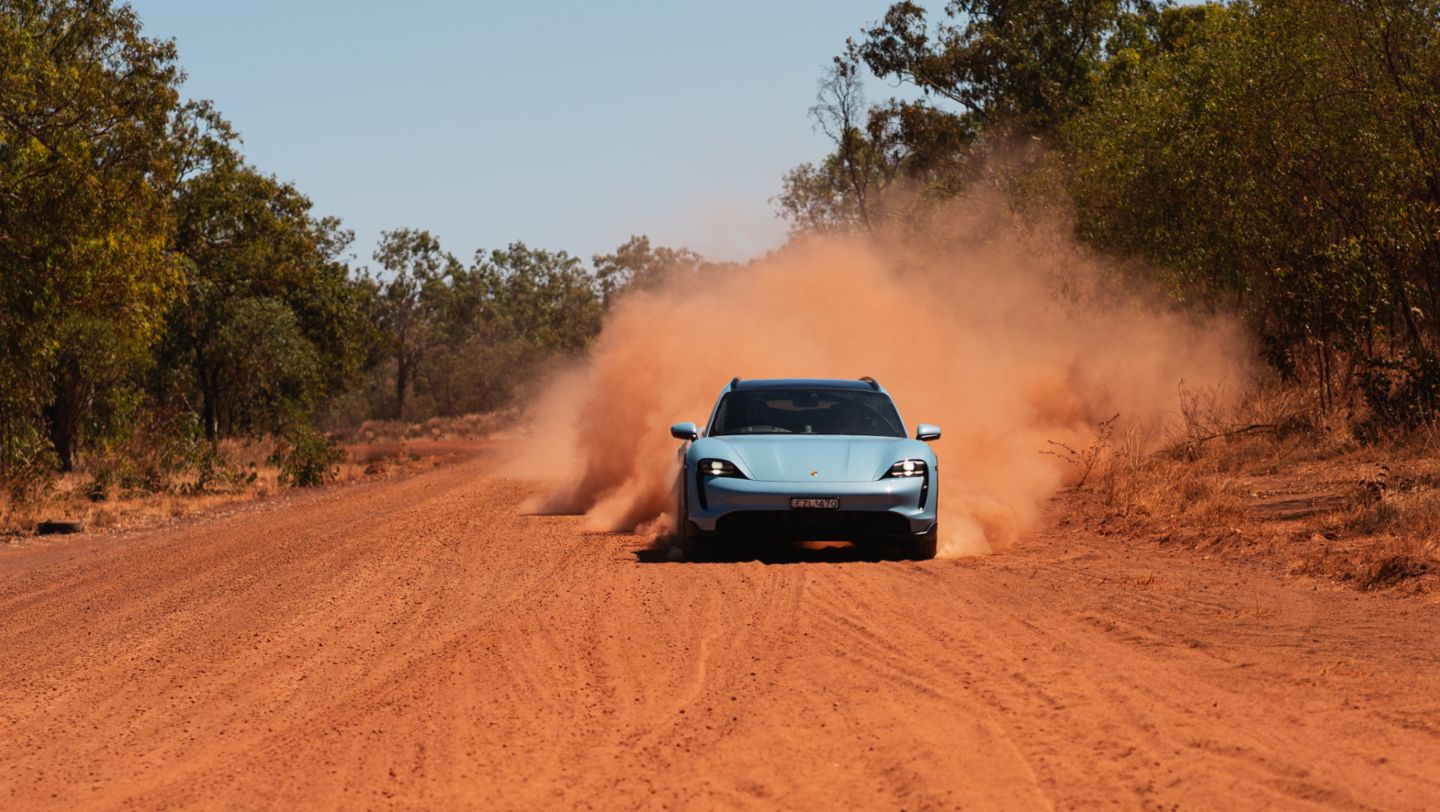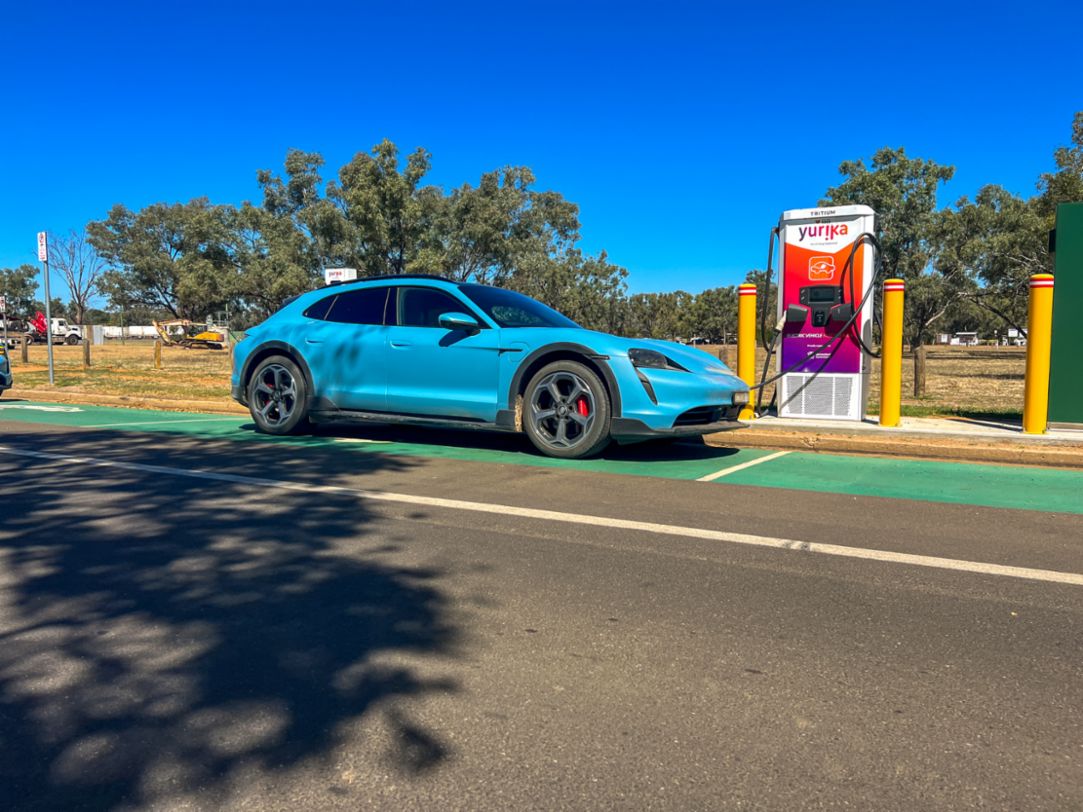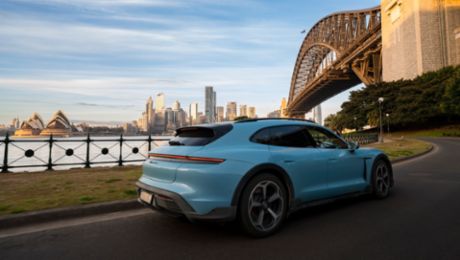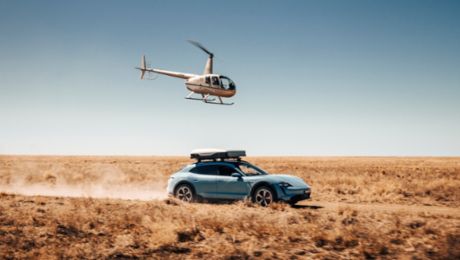But 5,000 kilometres in a Porsche Taycan Cross Turismo across some of the most remote parts of the country shows it can be done.
The ambitious Darwin to Bondi adventure in a Taycan 4S Cross Turismo utilised existing EV charging networks, regular household powerpoints and three-phase power outlets typically reserved for commercial operations and factories.
Sure, it required some planning and flexibility, but the epic journey was proof that EVs are very ready for all that Australia has to offer – and more.
Here the Porsche Cars Australia team reveals the inside story of what it took to get an electric Porsche across the country.
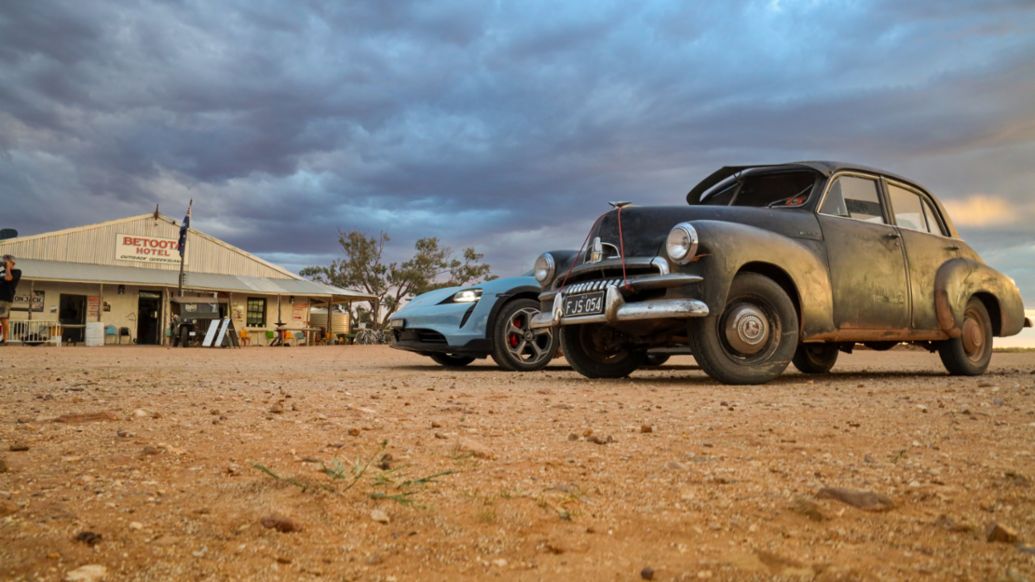
Beer and electrons
To kick off, though, it’s time for a refreshment … at the Betoota pub, where few (if any) EVs have ever been.
The characterful watering hole in south-western Queensland is not the sort of place you’d expect to charge an electric car. Until its reopening in 2020 you couldn’t even get a beer there - or anywhere within 150 kilometres.
It’s harsh, desolate country where rocks outnumber trees and the flies can be very friendly.
The beer now flows freely but you can forget about mobile coverage and luxuries such as cafes.
Yet the Porsche Cars Australia team had the Taycan Cross Turismo plugged in to soak up some much-needed electrons.
Sure, it was a slow charge. But it was a charge - and a way to keep the ambitious Darwin to Bondi electric road trip rolling.
In with a plan
As with any road trip, there’s a degree of planning. For an EV it requires more forethought so you know what to expect and can enjoy the stunning scenery and culture Australia does so well.
Any EV owner who’s left the security of their home charging station in the rear vision mirror will know that PlugShare is a great way to find charging stations all over the country and how much power each can supply.
Except if the team been relying on PlugShare alone then the Darwin to Bondi adventure never would have happened.
That’s because the user-generated data that keeps the app ticking suggests there is no charging at places such as Betoota, Bedourie and Boulia – three of the more far-flung locations on the 5,000 kilometre-plus journey.
Except there is – because everyone has electricity. And if you need to you can simply plug in to a household powerpoint.
The trick is finding where to access it.
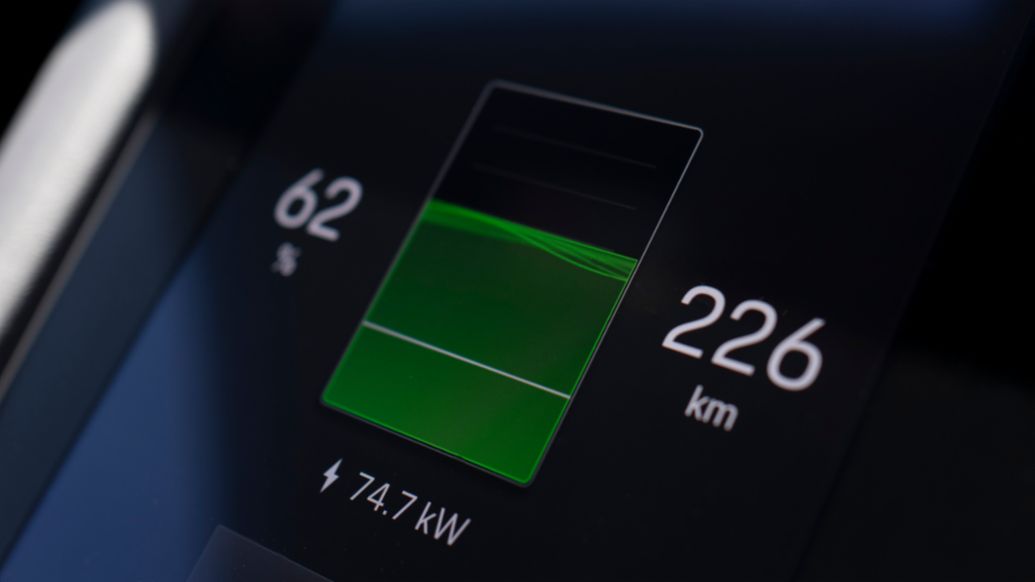
Hitting the phones
Our search inevitably involved scouring Google Maps to look for factories, sports fields and other locations where three-phase electricity could be lurking.
With up to 10 times more power than a home powerpoint, three-phase outlets can turn an overnight charge into one that takes a couple of hours.
For our Taycan 4S Cross Turismos – with a 93.4 kWh battery pack, of which 83.7 kWh is useable – it’s the difference between a circa-45-hour charge and a four-hour one.
But even if it was standard household power, we were prepared to take it; with the luxury of time you get the same result as a fast charge.
There were no generators following our road trip. The plan was to utilise the established electricity networks already available.

Spreading wide
Speaking of time, if you had plenty then you could engage the cruise control and go with the flow.
But the schedule needed a degree of certainty to keep the wheels rolling.
So the team created a plan that outlined locations and distances and estimated the state of charge prior to plugging in as well as how much electricity would go into the car.
Keep in mind that charging an EV is different to a petrol or diesel vehicle in that not all the electricity that leaves the power outlet ends up in the battery pack.
As is the case with all electrical circuits there are losses along the way, particularly with slower AC charging, which utilises the vehicle’s onboard charger – thereby going through another network of potential electrical resistance.
Those charging losses can hover around 5-10 per cent, but for the purposes of planning that estimation was increased to 15 per cent, just to build in a buffer.
Similarly, if there was uncertainty about the power output of the three-phase plug the plan said was there – there’s only so much detail you can get online – it was assumed it was outputting a lower amount.
You’d rather have the welcome surprise of only having to charge for half as long – the team scored many! – rather than the other way around.
A country smile
In many instances finding the right person to talk to was key to gaining access to a charging location.
Once the manager/owner/person in charge was on the other end of a phone line the overwhelming reception was supportive.
People in the remote towns love to help.
And even with an electric car better suited to a race track than the parched Aussie outback there was a willingness to keep the wheels turning.
Besides, even at AUD $1 per kilowatt-hour – triple what most people would pay for electricity at home – running a Taycan is still cheaper than touring the country powered by fossil fuels.
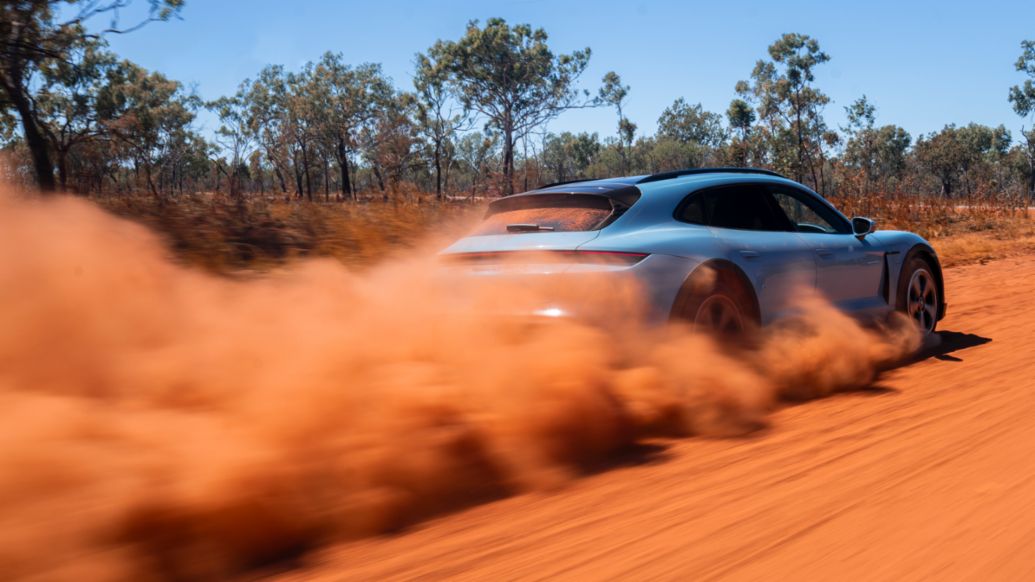
Going prepared
Another essential before heading off is making sure you’ve got the right charging hardware.
Ideally you want to be able to utilise any three-phase plug – there are three subtly different versions – as well as a regular 230V powerpoint and one supplying up to 15 amps (household plugs in Australia supply 10 amps).
We had Juice Boosters, which team a 22 kW portable charger with different ‘tails’ that clip on, depending on what you’re plugging into.
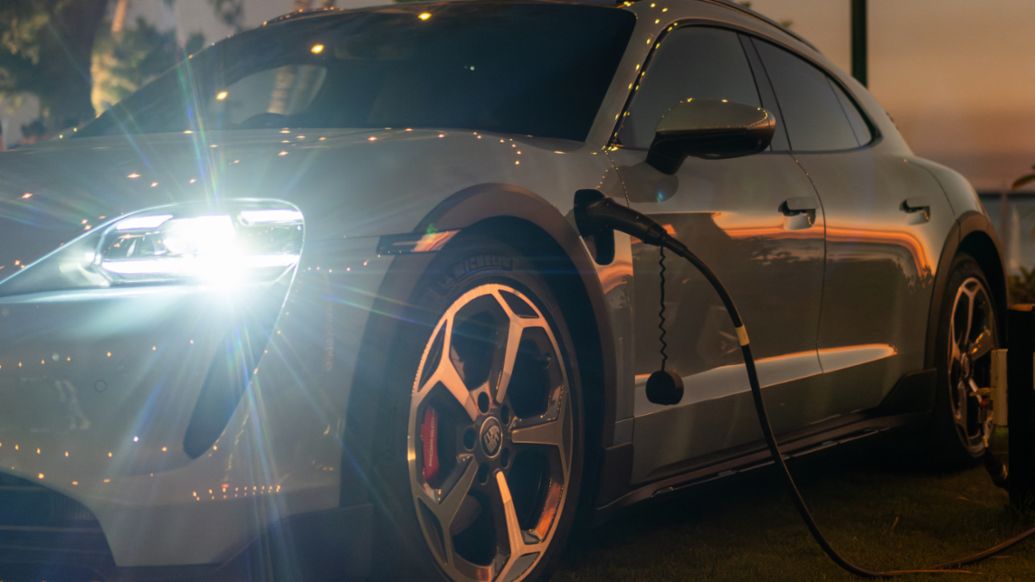
There were five different tails: the three three-phase options, a regular home powerpoint and a 15-amp three-pin powerpoint, which looks like a standard powerpoint but has a longer earth pin. Those 15A plugs are common in caravan parks, giving us yet another back-up if required.
A Type 2 to Type 2 adapter is also a handy addition, allowing you to utilise EV charging stations that don’t supply their own cable (yes, they do exist).
It also pays to have accounts for the major charging networks as well as the apps on your phone. In remote areas you could mainly be relying on other power supplies, it still pays to be prepared for Evie, Chargefox, Jolt, AmpCharge and BP Pulse.
Plan for charging
Early on in the Darwin to Bondi road trip there was reliable three-phase power.
From hotels to caravan parks there was a steady supply of electricity that meant a stop for an hour or two, sometimes three.
Clearly with these added stops it’s not as quick as going down the Stuart Highway at 130 km/h – the maximum speed limit anywhere in Australia’s Northern Territory - in something powered by petrol or diesel.
But, equally, it was also nothing like the impost some may envisage, especially if your goal is to soak up the sights of the outback.

At the Pine Creek Hotel, for example, the team simply scheduled in a lunch stop. They plugged the cars into the three-phase outlets around the back of the pub – right alongside a well-worn LandCruiser - and tucked into the outback feast.
It helped that our Taycan had the optional 22 kW onboard AC chargers, doubling the rate at which electricity could feed into the battery pack.
As with any road trip, there’s a degree of planning.
The ease with which the Taycan was charging early on was unexpected.
It was to the point where Mayk Wienkötterm, global spokesperson for Taycan and electromobility at Porsche, commented that the charging supply was better than what you’d find in many parts of Germany.
The difference in Australia is that often the infrastructure around the three-phase outlets was limited, to say the least.
If the Darwin to Bondi team wanted to use the laundry facilities of a caravan park, then there were multiple options.
If the team wanted a slick café or local homewares store, that was a lot tougher.
Eyes open
Finding three-phase power outlets wasn’t always easy – even when you know there is one vaguely nearby.
At Mataranka Homestead, for example, the team was handed a mud map of the sprawling campground.
The trademark fluoro highlighter on a photocopy outlined where the three-phase plug was, but that didn’t help trying to work out the orientation of the map.
As with others that were encountered, the power outlet was alongside the amenities block.
Then it was a short stroll to the stunning Bitter Springs swimming hole to soak in the crystal clear 34-degree water.
It’s the sort of place that no traveller would bypass in this part of the country. And while most visitors may ordinarily have parked 100 metres closer to the walking track, it was hardly an inconvenience.
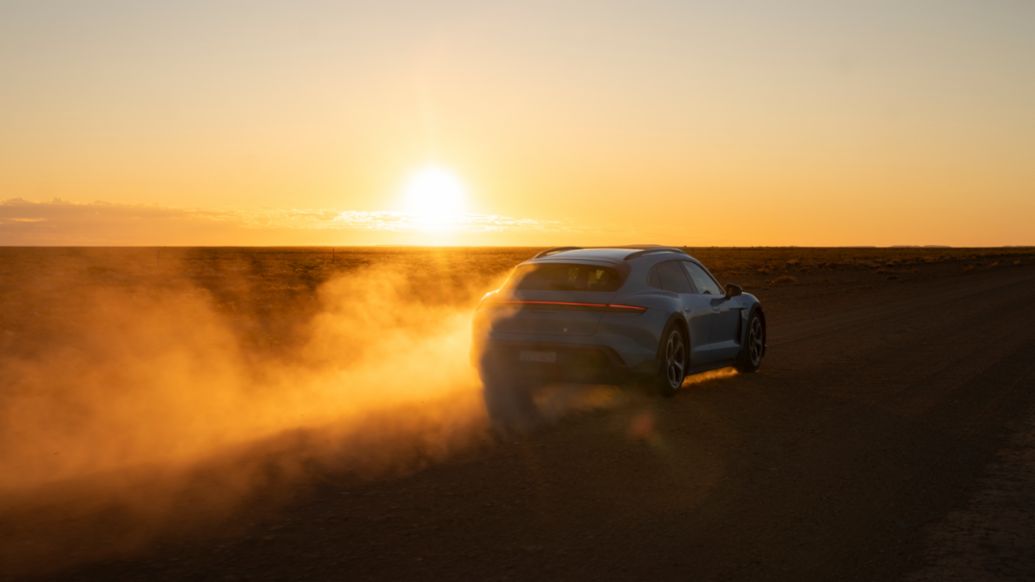
Getting greedy
With this trip we expected challenges and the first came at the Larrimah Pink Panther Hotel (yes, there really is a giant pink panther to greet you, beer bottle and all).
The publican pointed the team to the three-phase outlet in the caravan park, which worked beautifully – until it tripped the power supply to the entire caravan park.
There were some disgruntled Grey Nomads who were probably mid-way through season 57 of Days of Our Lives before having the screen go blank.
But, hey, it’s one of the challenges with EVs.
The ease with which the Taycan was charging early on was unexpected.
The Taycan was hungry for electricity and will take what it can get (or want) from whatever outlet you’re plugged in to. If others are utilising the same supply then the combination can overwhelm the local grid.
Keep in mind that it’s no different to power anywhere else in the country. If you plug enough high-powered items into your home powerpoints you’ll eventually exceed its limitations, activating a load protecting switch (which is exactly what the team had done).
There were two solutions: plug into a lower-powered outlet or stop charging.
Fortunately for this leg they could do without the faster charge, so they plugged into a standard powerpoint – rather than the higher output three-phase one – to sneak a small amount, leaving the rest to the caravanners.
If needed, they could have simply stayed longer to complete that slower charge.
Either way, it was a valuable early lesson to grab electricity wherever and whenever you can – only because there could be issues elsewhere down the road.
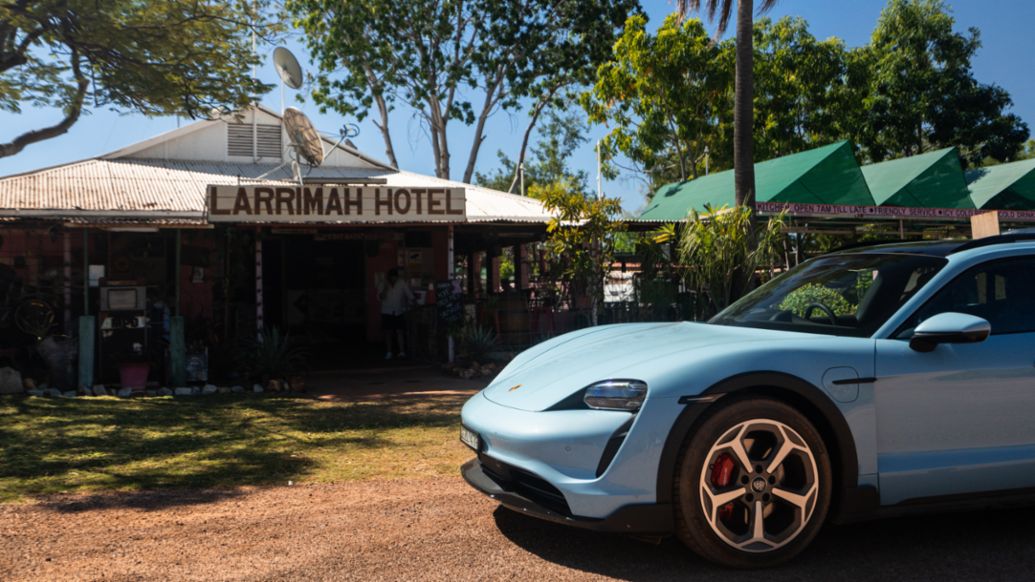
Knowledge is power - literally
Some research ahead of time can also help with physically locating the appropriate power supply.
At the Threeways Roadhouse north of Tennant Creek, for example, there were blank looks when the team asked for the location of the three-phase power supply.
Fortunately, users of PlugShare had included enough detail and a couple of images to help them navigate directly to it.
A quick scour around some motel rooms and they had their target, the non-descript plug adjacent to a meter box.
The brief top-up was an important one ahead of a circa-500 kilometre run east that would require some restraint on the right foot to maximise the range.
All EVs consume more electricity at freeway speeds due to aerodynamic drag.
As the team learnt during the Taycan adventure, simply dropping the speed back to about 90 kilometres/h could significantly extend the driving range.
It was a handy helper when they did have longer stretches between power outlets – or if they knew they’d be back-tracking to capture content.
But, again, there were backups. In one instance they phoned a cattle station to ask if they could use a powerpoint. It was all about leveraging the electricity they knew was there.
Taking sides
One thing that wasn’t immediately obvious as they drove out of Darwin was the benefits of being able to choose which side of the car to charge from.
The Taycan is a rarity in the EV world that gives you a Type 2 plug behind each front wheel, allowing you to choose which side to AC charge from.
There were times that it was handy, such as charging in a workshop attached to the Simpson Desert Oasis Roadhouse at Bedourie. It has some busy, well-stocked sheds that – unsurprisingly – don’t prioritise EV charging. So being able to nose in to shorten the stretch of the cable was a bonus.
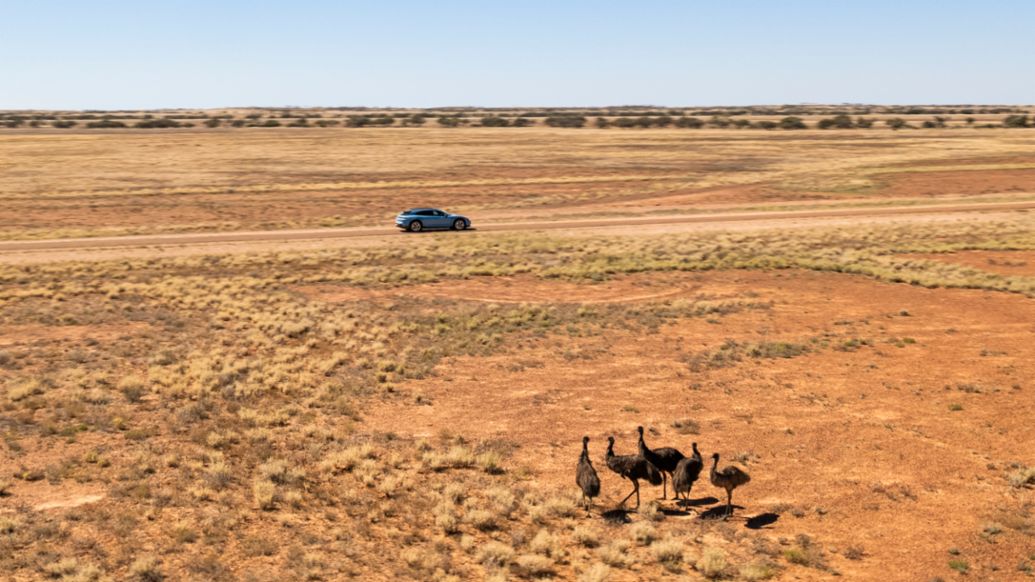
There were also times when it meant the difference between charging and going without. At the Birdsville Pub, for example, the full 22 kW three-phase outlet was overloading the system.
So they instead plugged in to a lower powered outlet near some of the hotel rooms. Angling the Taycan between two tight gates and butting up to a shipping container got the job done with millimetres to spare. Just. But, again, if they had been limited to one side they may have been searching for a plan C.
Welcome surprise
The deeper the team ventured into the outback the more they realised there is often decent power where you least expect it. And not many in town necessarily know about it, which means trying to find the right person to talk to.
That was the case in Boulia, a small town in western Queensland.
Again, the PlugShare app suggested there was nothing around, so they simply assumed they would be slow charging from a standard powerpoint. It was part of the pre-trip plan, although that never stopped them searching for something better.
On driving into town it was obvious there was some decent industry that would have significant electricity requirements.
The contracted roadworkers had an impressive warehouse with three-phase power and a lovely team that welcomed the Taycan.
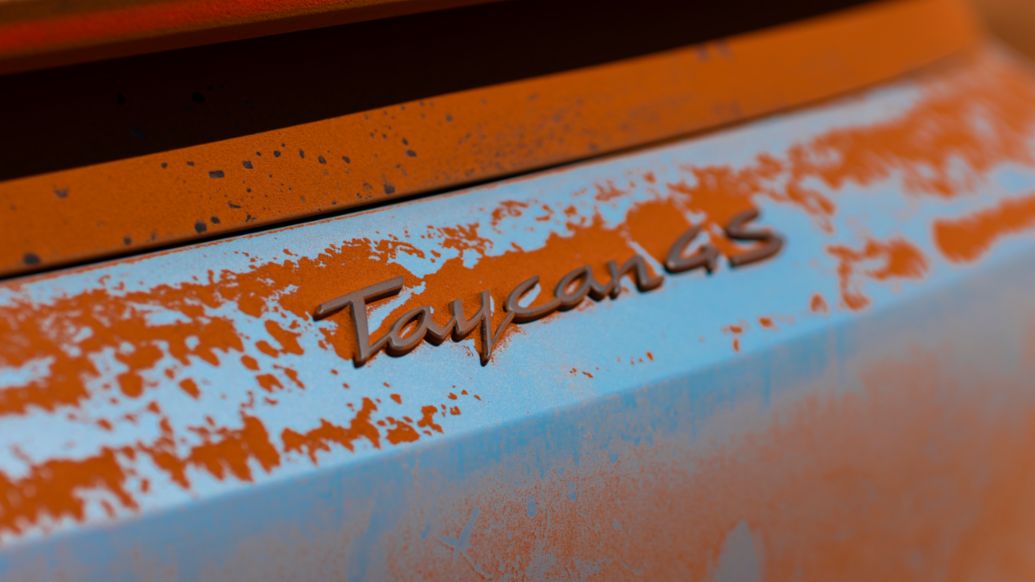
A few hours later and the state of charge was back up to 100 per cent.
Similarly, Windorah was somewhere they had assumed they would be using the local caravan park for power.
But the owner of the Western Star Hotel Motel had recently installed three-phase power and was more than happy for them to plug in. With a full 22 kW on offer, what was expected to be a trickle turned into a swift top-up.
Keeping it clean
In the end it was Betoota that created something of a challenge with charging.
The pub runs on a diesel generator, which is not the ideal way to charge an EV.
It’s the reality of some very remote power systems, although the affordability of renewables is tempting many to plan for solar and wind, instantly swinging the environmental equation.
But the challenges of a relatively compact generator go beyond its emissions. There’s also the issue of getting an EV to accept the charge.
The pub runs on a diesel generator, which is not the ideal way to charge an EV.
Once you plug in and start pulling power the voltage momentarily drops. It’s the first sign that the electricity supply isn’t necessarily clean and consistent.
Fine for some lights and music, but the finely honed – and carefully monitored – charging system of a high-performance electric Porsche was less enamoured with what was on offer.
A red light signalled the Taycan had enabled its protection systems and stopped the charging. The team unplugged, reset and tried again. And again, and again.
At one stage the publicans – who were helpful beyond what was ever expected – even provided a temporary load on the generator to reduce that short-lived initial voltage drop.
It worked to the point where they had enough to keep motoring.
When they eventually convinced the publicans to let them pay for the electricity, they put the cash straight into the Royal Flying Doctor Service donation tin.
It gives you an idea of the generosity and spirit of so many people in the outback.
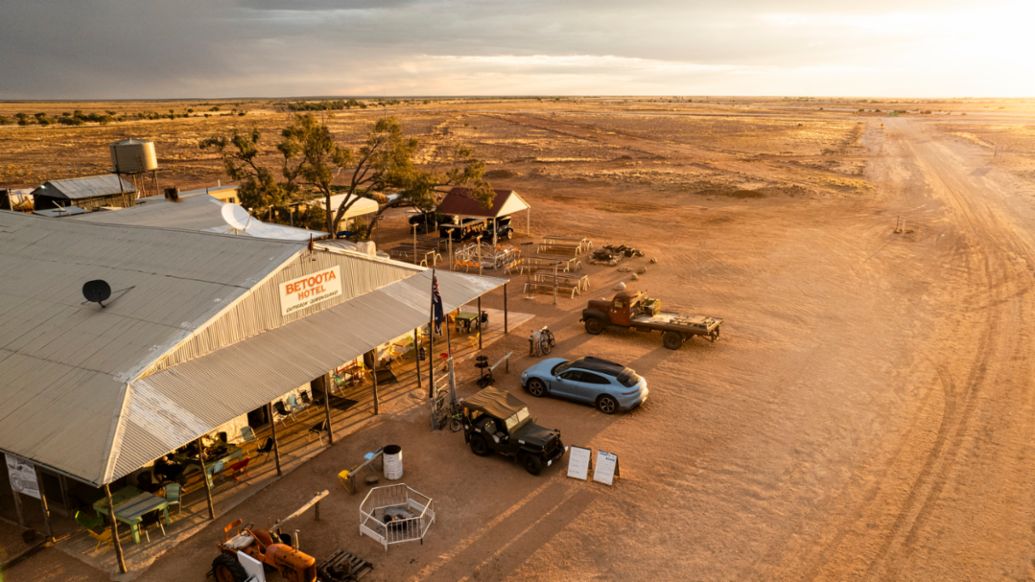
Powering on
By the time the team reached towns such as Longreach, Blackall and Bourke the charging got a lot easier.
They’re remote outback outposts that for many will be as far as they venture.
Yet for an EV they’re surprisingly easy to reach.
Having access to 50 kW or 75 kW dedicated EV chargers suddenly drops your charge time to an hour or less, depending on the original state of charge.
Given the array of things to do – starting with the Qantas museum in Longreach or the Blackall aquatic centre with its balmy artesian water – there were many times the car was on 100 per cent way before the team was ready to move on.
Those higher-powered charges made the last 1500-odd-kilometres through outback Queensland and New South Wales so much easier. The planning and thinking ahead was out the window. Simply roll up and plug in.
There was even a scheduled stop at Spicers Sangoma Retreat to utilise the Porsche Destination Charger at the secluded luxury sanctuary in the Blue Mountains.
As with so many Australian road trips, though, it’s the journey that’s often as significant as the destination.
With an EV you can throw in the sense of achievement of traversing the country solely on electrons.
Yes, it really can be done – and it’s a lot easier than you may expect.
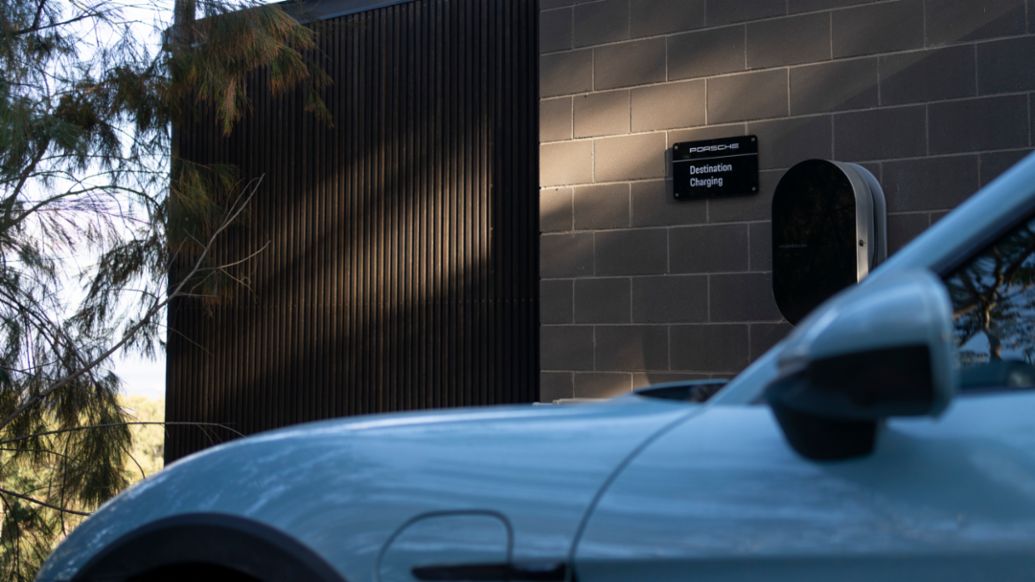
Australian EV road trip: Checklist
- Download the PlugShare app to learn what charging is available
- Create accounts for EV charging networks such as Chargefox, Evie, AmpCharge, Jolt and BP Pulse
- Don’t be afraid to pick up the phone to find additional charging options. Remember, everywhere has electricity!
- Pack the appropriate charging hardware for the places you’re planning to charge
- Look for nearby eating spots or tourist locations for when you’re charging
- Enjoy the drive and everything an Australian Outback trip has to offer!
